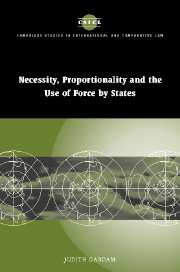Book contents
- Frontmatter
- Contents
- Foreword
- Preface
- Acknowledgments
- Table of cases
- List of abbreviations
- 1 The place of necessity and proportionality in restraints on the forceful actions of States
- 2 Necessity, proportionality and the forceful actions of States prior to the adoption of the United Nations Charter in 1945
- 3 Proportionality and combatants in modern international humanitarian law
- 4 Proportionality and civilians in modern international humanitarian law
- 5 Necessity, proportionality and the unilateral use of force in the era of the United Nations Charter
- 6 Necessity, proportionality and the United Nations system: collective actions involving the use of force
- Bibliography
- Index
- Cambridge Studies in International and Comparative Law
5 - Necessity, proportionality and the unilateral use of force in the era of the United Nations Charter
Published online by Cambridge University Press: 16 July 2009
- Frontmatter
- Contents
- Foreword
- Preface
- Acknowledgments
- Table of cases
- List of abbreviations
- 1 The place of necessity and proportionality in restraints on the forceful actions of States
- 2 Necessity, proportionality and the forceful actions of States prior to the adoption of the United Nations Charter in 1945
- 3 Proportionality and combatants in modern international humanitarian law
- 4 Proportionality and civilians in modern international humanitarian law
- 5 Necessity, proportionality and the unilateral use of force in the era of the United Nations Charter
- 6 Necessity, proportionality and the United Nations system: collective actions involving the use of force
- Bibliography
- Index
- Cambridge Studies in International and Comparative Law
Summary
Introduction
Chapter 2 considered the early development of necessity and proportionality as components of the law on the use of force by States during the period prior to the Second World War (1939–45). This chapter analyses the content of these principles under the United Nations Charter regime, and encompasses a consideration of their operation in the context of self-defence, both individual and collective, the so-called right of humanitarian intervention and reprisals involving the use of force. As will become apparent, although the demands of necessity are readily identifiable in the practice of States, the detailed operation of proportionality in modern ius ad bellum is somewhat clouded in obscurity and awaits further clarification. Nevertheless, it is possible to distil from State practice a legal framework for the proportionality principle and to identify, albeit tentatively, concrete obligations derived from its constraints.
The United Nations Charter fundamentally changes the pre-existing law on the use of force. Despite considerable contrary State practice, there remains an uneasy consensus that States must limit their unilateral forceful actions to individual and collective self-defence in response to an armed attack. Under the Charter system, therefore, it is the scope of self-defence itself that is the first criterion a State will need to consider when deciding whether or not to take forceful action. What constitutes an armed attack? If a State is subjected to actions that meet the description of an armed attack, it must then assess whether a forceful response is necessary.
- Type
- Chapter
- Information
- Necessity, Proportionality and the Use of Force by States , pp. 138 - 187Publisher: Cambridge University PressPrint publication year: 2004

